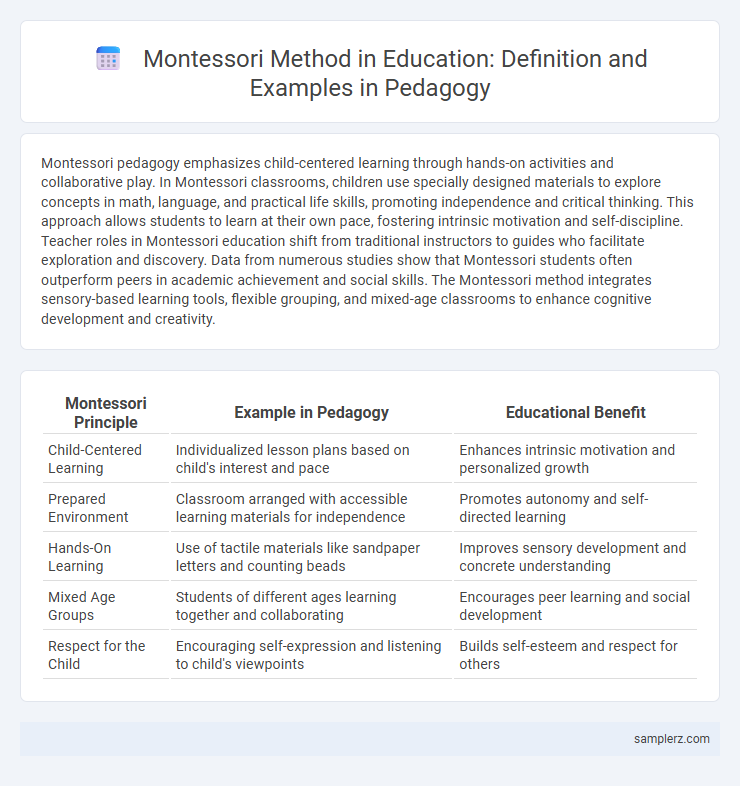Montessori pedagogy emphasizes child-centered learning through hands-on activities and collaborative play. In Montessori classrooms, children use specially designed materials to explore concepts in math, language, and practical life skills, promoting independence and critical thinking. This approach allows students to learn at their own pace, fostering intrinsic motivation and self-discipline. Teacher roles in Montessori education shift from traditional instructors to guides who facilitate exploration and discovery. Data from numerous studies show that Montessori students often outperform peers in academic achievement and social skills. The Montessori method integrates sensory-based learning tools, flexible grouping, and mixed-age classrooms to enhance cognitive development and creativity.
Table of Comparison
| Montessori Principle | Example in Pedagogy | Educational Benefit |
|---|---|---|
| Child-Centered Learning | Individualized lesson plans based on child's interest and pace | Enhances intrinsic motivation and personalized growth |
| Prepared Environment | Classroom arranged with accessible learning materials for independence | Promotes autonomy and self-directed learning |
| Hands-On Learning | Use of tactile materials like sandpaper letters and counting beads | Improves sensory development and concrete understanding |
| Mixed Age Groups | Students of different ages learning together and collaborating | Encourages peer learning and social development |
| Respect for the Child | Encouraging self-expression and listening to child's viewpoints | Builds self-esteem and respect for others |
Introduction to Montessori Pedagogy
Montessori pedagogy emphasizes self-directed learning through hands-on activities and sensory experiences, fostering autonomy and concentration in children. Materials like the Pink Tower and Sandpaper Letters enable concrete understanding of abstract concepts, promoting cognitive development. This approach also nurtures social skills by encouraging collaborative play within a prepared environment tailored to individual learning paces.
Core Principles of Montessori Education
Montessori education emphasizes self-directed learning, hands-on activities, and mixed-age classrooms to foster independence and intrinsic motivation. Core principles include respect for the child's natural psychological development, a prepared environment that encourages exploration, and the teacher's role as a facilitator rather than an instructor. This pedagogy promotes concentration, freedom within limits, and collaborative play to support holistic development.
Prepared Environment in Montessori Classrooms
Montessori classrooms emphasize a Prepared Environment designed to promote independent learning through carefully arranged materials and accessible resources tailored to children's developmental stages. This environment includes child-sized furniture, organized workstations, and natural materials that support exploration and sensory development. The Prepared Environment fosters autonomy, concentration, and intrinsic motivation by encouraging students to engage actively with hands-on learning activities.
Role of the Montessori Teacher
The Montessori teacher acts as a guide who creates a prepared environment tailored to individual learning needs, fostering independence and self-directed activity. This educator carefully observes students to assess their developmental progress and intervene only when necessary, promoting intrinsic motivation and confidence. Emphasizing hands-on learning and sensory-based activities, the teacher facilitates exploration without direct instruction, enabling children to construct knowledge through experience.
Self-Directed Learning in Montessori Practice
Montessori pedagogy emphasizes self-directed learning by providing a carefully prepared environment that encourages children to choose activities aligning with their interests and developmental stages. Materials such as sensory-based tools, practical life exercises, and hands-on manipulatives empower students to explore concepts independently while fostering intrinsic motivation. This approach nurtures autonomy, critical thinking, and a lifelong love of learning by supporting the child's natural curiosity and ability to guide their educational journey.
Montessori Materials and Their Educational Purpose
Montessori materials such as the Pink Tower, Brown Stair, and Sandpaper Letters are designed to engage multiple senses and promote self-directed learning by allowing children to explore concepts of size, color, texture, and language independently. These hands-on tools support cognitive development, motor skills, and concept formation through concrete manipulation, fostering a deep understanding of abstract ideas. Their educational purpose is to cultivate concentration, coordination, order, and a love for learning, aligning with Montessori pedagogy's emphasis on individual pace and experiential discovery.
Fostering Independence and Responsibility
Montessori pedagogy fosters independence and responsibility through self-directed learning, allowing students to choose activities that match their interests and developmental stages. This approach encourages hands-on experiences and practical life skills, promoting autonomy and decision-making in a structured environment. By nurturing intrinsic motivation, Montessori classrooms cultivate responsible behavior and confidence in young learners.
Mixed-Age Grouping: Collaborative Learning
Montessori pedagogy emphasizes mixed-age grouping, where children aged 3 to 6 learn together to foster peer collaboration and social development. This structure encourages older students to mentor younger peers, enhancing leadership skills while reinforcing their own understanding. Collaborative learning within these groups promotes individualized pacing and diverse interactions, aligning with Montessori's hands-on, self-directed educational philosophy.
Practical Life Activities in Montessori Pedagogy
Practical Life Activities in Montessori pedagogy emphasize hands-on tasks that develop fine motor skills, independence, and concentration in children aged 3 to 6. These activities include pouring, spooning, dressing frames, and cleaning, which foster self-discipline and coordination. Montessori classrooms integrate these exercises to build foundational life skills, promoting autonomy and confidence essential for holistic child development.
Real-World Examples of Montessori in Action
Montessori classrooms emphasize hands-on learning with materials like sandpaper letters and practical life tools to foster independence and sensory development. In practice, students engage in activities such as gardening, where they observe plant growth and develop responsibility, reflecting real-world ecological principles. These experiences cultivate critical thinking and a deep connection to their environment, demonstrating Montessori's impact on experiential education.

example of montessori in pedagogy Infographic
 samplerz.com
samplerz.com